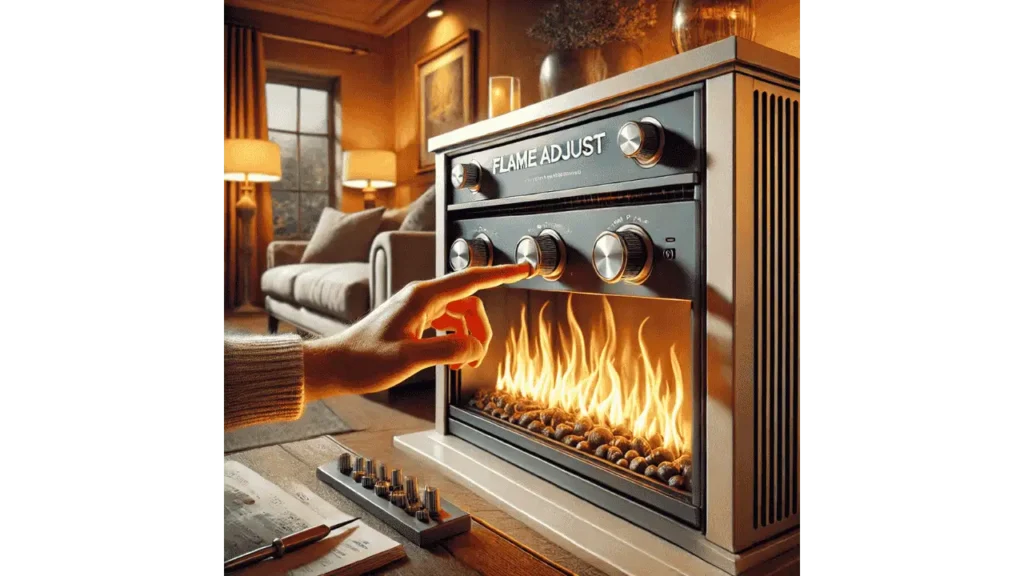Adjusting the flame on a gas fireplace is a simple yet effective way to ensure it operates efficiently and provides the desired level of warmth and ambiance. Whether you want to lower the flame for energy efficiency or increase it for more heat output, understanding the right steps can make the process straightforward. This guide covers why adjusting the flame is necessary and how to do it safely.
Why Adjusting the Flame Is Important?
Maintaining the right flame height is essential for both comfort and safety. A flame that is too high can waste fuel and generate excessive heat, potentially damaging fireplace components. On the other hand, a low flame may not provide sufficient warmth and could indicate underlying issues with the gas supply or burner.
Proper flame adjustment can help maintain energy efficiency, prolong the lifespan of the fireplace, and enhance the overall ambiance of the room. It also ensures that the unit operates within manufacturer guidelines, preventing potential hazards.
Understanding the Flame Adjustment Controls
Manual Control Knob
Many gas fireplaces feature a manual control knob that allows users to adjust the flame height easily. This knob is typically located behind the fireplace’s access panel and can be turned to increase or decrease the flame.
Remote Control or Wall Switch
Some modern fireplaces come with remote controls or wall switches that provide easy access to flame adjustment settings. These systems allow for quick adjustments without having to open the unit.
Thermostat Adjustment
Fireplaces with built-in thermostats adjust the flame automatically to maintain a set temperature. This feature helps optimize fuel consumption and ensures consistent room warmth.
Step-by-Step Guide to Adjusting the Flame
Step 1: Turn Off the Fireplace
Before making any adjustments, ensure the fireplace is turned off and cool to the touch. This prevents accidental burns and allows for safe handling of controls.
Step 2: Locate the Control Knob or Switch
Identify the control mechanism on your fireplace. It could be a knob located behind the panel, a remote control, or a wall switch.
Step 3: Adjust the Flame Height
Gradually turn the knob or use the control interface to adjust the flame to the desired height. Avoid making sudden changes, as this could impact combustion efficiency.
Step 4: Observe the Flame Pattern
Once adjustments are made, observe the flame to ensure it is even and blue with minimal yellow tipping. Uneven or excessively yellow flames may indicate a problem with the gas-to-air ratio.
Step 5: Test and Make Further Adjustments
After observing the flame, make additional adjustments if needed to achieve the desired look and heat output. Test the settings by running the fireplace for a few minutes.
Common Issues When Adjusting the Flame
Uneven Flame Distribution
If the flame appears uneven, the burner may need cleaning. Dust or debris buildup can obstruct gas flow, leading to an irregular flame pattern.
Weak Flame Output
A weak flame may indicate low gas pressure or a partially closed valve. Ensure the gas supply is fully open and that the regulator is functioning correctly.
Flame Too High or Too Low
If the flame height is not adjusting as expected, the control valve may require servicing or replacement. Consulting the manufacturer’s manual can help identify the issue.
When to Call a Professional
If adjustments do not resolve the issue or if the flame pattern remains inconsistent, it may be time to call a professional. A qualified technician can inspect the gas line, burner, and control system to diagnose and fix any underlying problems.
Key Takeaways
Adjusting the flame on a gas fireplace is an essential process that enhances comfort and efficiency. Understanding the control mechanisms and making gradual adjustments can help achieve the perfect flame height. Regular maintenance and prompt attention to irregular flame patterns ensure the fireplace continues to operate safely and effectively.
- 27 Farmhouse Fireplace Ideas That Bring Warmth & Charm - August 18, 2025
- 25 Fireplace Lighting Ideas to Illuminate Your Hearth - August 7, 2025
- How to Replace an Electric Fireplace Switch? - August 5, 2025



